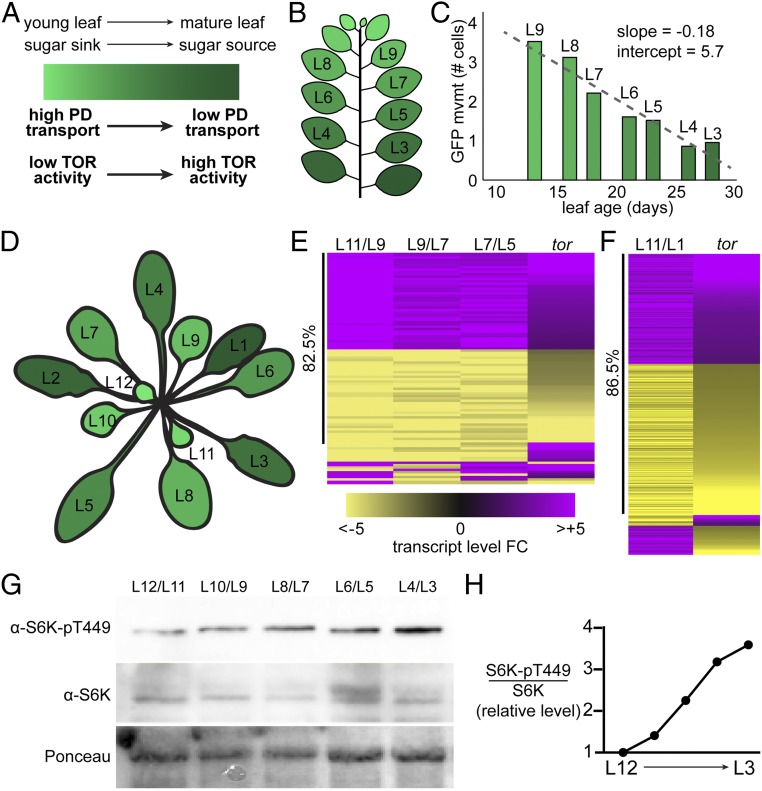Fig. 5.
TOR activity coordinates leaf metabolism with leaf age. (A) As leaves age, they transition from young sinks (light green) that rapidly consume sugars to mature sources (dark green) that photosynthesize excess sugars for export to the rest of the plant. Here, we show that TOR activity steadily increases and PD transport steadily decreases during this transition. (B) Leaf emergence of N. benthamiana plants was tracked for 6 wk, during which time 13 leaves emerged. The first true leaf is labeled leaf 1 (L1), and subsequent leaves are numbered by order of emergence. (C) Six weeks after germination, PD transport in L9 (a relative sink leaf) through L3 (a relative source leaf) was quantified using the GFP movement assay. PD transport was assayed in the proximal 25% of every leaf. PD transport decreases linearly with leaf age (as in ref. 53) in N. benthamiana. (D) Schematic of an Arabidopsis vegetative rosette used for transcriptomes and the Western blot analyses in this figure. (E–H). (E) The sets of genes that are differentially expressed in Arabidopsis leaves of different ages significantly overlap with the tor transcriptome (P < 10−26), and are highly coregulated (82.5%), indicating that the TOR-promoted transcriptional program is activated as leaves mature (Dataset S7). The tor transcriptome is the set of gene-expression changes that respond to glucose only in the presence of TOR (40), and are therefore transcriptional targets of the TOR signaling pathway. Pairwise analyses of DEGs for L11 and L9, L9 and L7, and L7 and L5 are shown, respectively, from left to right. As an example, a gene is considered “induced” in the L11/L9 dataset if it is significantly more highly expressed in L11 than in L9. (F) Over 30% of the glucose-TOR target genes (732 of 2,350, P < 10−138) are significantly differentially expressed between a young sink leaf (L11) and a mature source leaf (L1), and the vast majority of these DEGs (86.5%) are coregulated, suggesting that the glucose-TOR signaling network is more active in source leaves than in sink leaves (Dataset S8). (G) S6K-Thr449 phosphorylation levels, a proxy for TOR activity in plant cells, were assayed by Western blot with a phospho-specific antibody. A 35SPRO:S6K1 transgenic Arabidopsis line was used for this experiment, because it maintains consistent S6K protein levels in leaves of different ages. S6K-Thr449 levels steadily increase with leaf age in an Arabidopsis rosette. Ponceau staining was used to show loading of total protein (Lower). (H) The quantified ratio of S6K-pT449 levels to total S6K levels in leaves of different ages confirms that TOR activity increases with leaf age in a mature Arabidopsis rosette.

